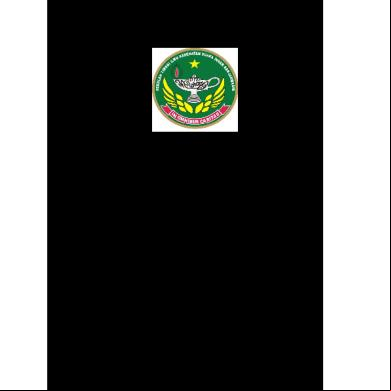Geological Work Of River 6u1v1x
This document was ed by and they confirmed that they have the permission to share it. If you are author or own the copyright of this book, please report to us by using this report form. Report 3b7i
Overview 3e4r5l
& View Geological Work Of River as PDF for free.
More details w3441
- Words: 266
- Pages: 14
WORK OF RIVER
THREE FUNCTIONS OF RIVER • EROSION • TRANSPORTATION • DEPOSITION
EROSION • A RIVER MAY ERODE IN 4 WAYS ABRASION/CORROSION Load carried by a river will grind against its bed and sides This process slowly wears the bed and sides away
ATTRITION • When thrown against the sides and bed of river,the load gets broken into smaller pieces
HYDRAULIC ACTION • The work of turbelence in the water • Running water causes friction in the ts of rocks in a stream channel
• ts may be enlarged • Loosened fragments of rocks get swept away
SOLUTION/CORROSION • Certain minerals in rocks like limestone can be dissolved in water • Rocks are then eroded
TRANSPORTATION
TRACTION • Larger and heavier rocks/gravels are dragged or rolled along the bed
SALTATION • Smaller and lighter rock fragments and sand hop and bounce along the river bed
SUSPENSION • Some of the load like silt and clay(fine-grained)will float along. • They may only be deposited when stream velocity reaches near zero
• Turbulence in the water is crucial in holding a load of sediments
SOLUTION • Some minerals are transported in dissolved form • Especially chemical solution derived from minerals like limestone or dolomite.
DEPOSITION • Thhe river will drop its load when • Volume decreases • Speed decreases
• A river volume decreases when • • • •
Dry season Dry region with high evaporation Presence of permeable rocks Receding flood waters
• A river speed decreases when • It enters a lake • It enters a calm sea • It enters a gently sloping plain
THREE FUNCTIONS OF RIVER • EROSION • TRANSPORTATION • DEPOSITION
EROSION • A RIVER MAY ERODE IN 4 WAYS ABRASION/CORROSION Load carried by a river will grind against its bed and sides This process slowly wears the bed and sides away
ATTRITION • When thrown against the sides and bed of river,the load gets broken into smaller pieces
HYDRAULIC ACTION • The work of turbelence in the water • Running water causes friction in the ts of rocks in a stream channel
• ts may be enlarged • Loosened fragments of rocks get swept away
SOLUTION/CORROSION • Certain minerals in rocks like limestone can be dissolved in water • Rocks are then eroded
TRANSPORTATION
TRACTION • Larger and heavier rocks/gravels are dragged or rolled along the bed
SALTATION • Smaller and lighter rock fragments and sand hop and bounce along the river bed
SUSPENSION • Some of the load like silt and clay(fine-grained)will float along. • They may only be deposited when stream velocity reaches near zero
• Turbulence in the water is crucial in holding a load of sediments
SOLUTION • Some minerals are transported in dissolved form • Especially chemical solution derived from minerals like limestone or dolomite.
DEPOSITION • Thhe river will drop its load when • Volume decreases • Speed decreases
• A river volume decreases when • • • •
Dry season Dry region with high evaporation Presence of permeable rocks Receding flood waters
• A river speed decreases when • It enters a lake • It enters a calm sea • It enters a gently sloping plain











